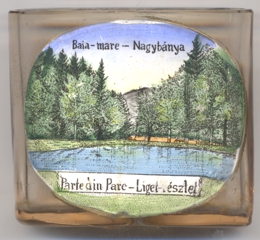

|
| ROMÂNIA | ROMANIA |
| județ Maramureș | Maramureș County |
Baia Mare is situated at an elevation of 228 m along the river Săsa on the western edge of the Eastern Carpatians of northern Romania, about 410 km northwest of Bucharest. The municipality is the capital of Maramureș County and has a population of about 108,800 (2021).
 During the Bronze Age the region was inhabited by Thracian tribes. Later, it was included in the Dacian Kingdom when mining for gold and silver began.
According to some historical researches, the first mention of the city dates back to 1142, but other sources think that the oldest document
mentioning (in Latin) Rivulus Dominarum ('Ladies' River', as in German: Frauenbach). In 1347 the town was identified in documents
as an important medieval town with a prosperous mining industry. Its rules of organisation were characteristic of the "free towns" of that time.
The town went into a period of prosperity. The first school, named Schola Rivulina, was opened in Baia Mare in 1547 by the Reformed Church following
the Protestant Reformation. In 1703 Pintea Viteazul and his band managed to free the town for a short period of time from the Imperial rule,
under which it belonged the royal treasury. Since then Pintea is considered an important figure in the town's history, representing the idea of freedom.
In 1748 the city's mining industry made a leap forward when the Austrian authorities created the headquarters of "Superior Mining". Within the AUstrian
Monarchy, Baia Mare was called Nagybánya in Hungarian, and Frauenbach in German. Following World War I, the Austro-Hungarian Empire
was dissolved, and in 1920, Baia Mare officially became part of the Kingdom of Romania. During World War II, in 1940, it was awarded back to
Hungary (Second Vienna Award), but returned to Romania after the war in 1945.
During the Bronze Age the region was inhabited by Thracian tribes. Later, it was included in the Dacian Kingdom when mining for gold and silver began.
According to some historical researches, the first mention of the city dates back to 1142, but other sources think that the oldest document
mentioning (in Latin) Rivulus Dominarum ('Ladies' River', as in German: Frauenbach). In 1347 the town was identified in documents
as an important medieval town with a prosperous mining industry. Its rules of organisation were characteristic of the "free towns" of that time.
The town went into a period of prosperity. The first school, named Schola Rivulina, was opened in Baia Mare in 1547 by the Reformed Church following
the Protestant Reformation. In 1703 Pintea Viteazul and his band managed to free the town for a short period of time from the Imperial rule,
under which it belonged the royal treasury. Since then Pintea is considered an important figure in the town's history, representing the idea of freedom.
In 1748 the city's mining industry made a leap forward when the Austrian authorities created the headquarters of "Superior Mining". Within the AUstrian
Monarchy, Baia Mare was called Nagybánya in Hungarian, and Frauenbach in German. Following World War I, the Austro-Hungarian Empire
was dissolved, and in 1920, Baia Mare officially became part of the Kingdom of Romania. During World War II, in 1940, it was awarded back to
Hungary (Second Vienna Award), but returned to Romania after the war in 1945.
Glass no. 4423 [left] is labeled in Romanian and Hungarian: Baia-mare – Nagybánya / Parte din Parc – Liget-fészlet ('park area').
Further places called Neustadt (or similar), of which glasses are in this collection, are:
[https://de.wikipedia.org/wiki/Baia_Mare, https://en.wikipedia.org/wiki/Baia_Mare]
in Austria:
in the Czech Republic:
in Germany:
in Hungary:
in Poland:
![[scale]](lineal.jpg)